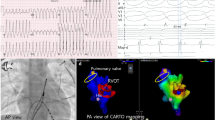Abstract
Purpose
Noninducibility of the clinical tachycardia is a major limitation while mapping and ablating idiopathic fascicular ventricular tachycardia (FVT). There is very little data on systematic induction protocols in this entity. Our aim was to study the role of systematic induction protocols in patients with clinically documented ventricular tachycardia (VT).
Methods
Programmed electrical stimulation was performed at baseline from high right atrium, right ventricular apex, right ventricular outflow tract and from left ventricle as per the protocol. Programmed ventricular stimulation was performed at two drive cycle lengths up to three extrastimuli and short-long-short sequence. If FVT remained non inducible at baseline, pharmacological provocation with isoprenaline/atropine/phenylephrine was used based on the baseline atrio-ventricular Wenckebach cycle length.
Results
This systematic induction protocol was studied in 68 patients with clinically documented FVT and sustained FVT was inducible in 64 patients (94 %). Of these 64 patients, pharmacological provocation was required in 18 patients (28 %) while in the remaining, sustained VT was induced at baseline. This high induction rate allowed ablation during tachycardia, which resulted in 100 % acute procedural success in the patients where sustained tachycardia could be induced. At a follow up of 29 ± 13 months, two patients (3 %) had recurrence.
Conclusions
Systematic induction protocol along with the appropriate use of pharmacological agents results in a high induction rate of FVT. This may result in more defined and limited ablation during tachycardia with better success rates and lesser recurrence.


Similar content being viewed by others
References
Zipes, D. P., Foster, P. R., Troup, P. J., & Pedersen, D. H. (1979). Atrial induction of ventricular tachycardia: reentry versus triggered automaticity. The American Journal of Cardiology, 44, 1–8.
Lin, D., Hsia, H. H., Gerstenfeld, E. P., Dixit, S., Callans, D. J., Nayak, H., Russo, A., & Marchlinski, F. E. (2005). Idiopathic fascicular left ventricular tachycardia: linear ablation lesion strategy for noninducible or nonsustained tachycardia. Heart Rhythm, 2, 934–939.
Nakagawa, H., Beckman, K., McClelland, J., Wang, X., Arruda, M., Santoro, I., Hazlitt, A., Abdalla, I., Singh, A., Gossinger, H., Sweiden, R., Hirao, K., Widman, L., Pitha, J., Lazzara, R., & Jackman, W. (1993). Radiofrequency catheter ablation of idiopathic left ventricular tachycardia guided by a Purkinje potential. Circulation, 88, 2607–2617.
Zardini, M., Thakur, R., Klein, G., & Yee, R. (1995). Catheter ablation of idiopathic left ventricular tachycardia. Pacing and Clinical Electrophysiology, 18, 1255–1265.
Wen, M. S., Yeh, S. J., Wang, C. C., Lin, F. C., Chen, I. C., & Wu, D. (1994). Radiofrequency ablation therapy in idiopathic left ventricular tachycardia with no obvious structural heart disease. Circulation, 89, 1690–1696.
Wissner, E., Menon, S. Y., Metzner, A., Schoonderwoerd, B., Nuyens, D., Makimoto, H., Zhang, Q., Mathew, S., Fuernkranz, A., Rillig, A., Tilz, R. R., Kuck, K. H., & Ouyang, F. (2012). Long-term outcome after catheter ablation for left posterior fascicular ventricular tachycardia without development of left posterior fascicular block. Journal of Cardiovascular Electrophysiology, 23(11), 1179–84.
Lerman, B. B., Stein, K. M., & Markowitz, S. M. (1997). Mechanism of idiopathic ventricular tachycardia. Journal of Cardiovascular Electrophysiology, 8, 571–583.
Okumura, K., & Tsuchiya, T. (2002). Idiopathic left ventricular tachycardia: clinical features, mechanism and management. Cardiac Electrophysiology Review, 6, 61–67.
Ramprakash, B., Jaishankar, S., Rao, H. B., & Narasimhan, C. (2008). Catheter ablation of fascicular ventricular tachycardia. Indian Pacing Electrophysiology Journal, 18(3), 193–202.
Nogami, A., Naito, S., Tada, H., et al. (2000). Demonstration of diastolic and presystolic Purkinje potentials as critical potentials in a macroreentry circuit of verapamil-sensitive idiopathic left ventricular tachycardia. Journal of the American College of Cardiology, 36, 811–823.
Tsuchiya, T., Okumura, K., Honda, T., et al. (1999). Significance of late diastolic potential preceding purkinje potential in verapamil-sensitive idiopathic left ventricular tachycardia. Circulation, 99, 2408–2413.
Conflict of interest
There are no conflicts of interest in connection with the submitted article.
Author information
Authors and Affiliations
Corresponding author
Rights and permissions
About this article
Cite this article
Gopi, A., Nair, S.G., Shelke, A. et al. A stepwise approach to the induction of idiopathic fascicular ventricular tachycardia. J Interv Card Electrophysiol 44, 17–22 (2015). https://doi.org/10.1007/s10840-015-0022-4
Received:
Accepted:
Published:
Issue Date:
DOI: https://doi.org/10.1007/s10840-015-0022-4




